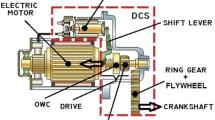Abstract
Stop–start vehicles (SSVs) represent a potential alternative for improving internal combustion engine (ICE) efficiency. SSVs provide ICEs with the functionality of turning the engine off during traffic halts and restarting it without intervention by the driver. This strategy reduces fuel consumption, especially in dense urban traffic areas, and contributes to emissions reduction to meet green emissions targets. The most widely adopted SSV system has a mechanical interface to connect the electric starter motor to the ICE, which requires increased robustness compared with standard starting motors. This requirement allows the motor to withstand a higher number of engine start cycles compared with a standard starting motor. Nevertheless, it is a critical problem for wider adoption of SSVs. As SSV systems usually are based on the conventional starting system, its durability and noise remains a critical issue to be addressed by automakers. The typical pinion–ring gear interface uses intermittent gear meshing to form a transient coupling interface. The research reported here presents the development of an innovative mechanical interface for starting systems, called the permanent coupling (PC)-type interface, which reduces noise and increases durability compared with the existing design. The results obtained by a functional prototype of the PC-type mechanical interface confirm the feasibility of the proposed concept. The methodology is based on a product development process integrated with lumped-parameter modeling and virtual simulation aimed at reducing failures during prototype testing. The new mechanical interface was proven to be a good candidate for increasing the use of SSVs in the automotive market.















Adapted from [24]



Similar content being viewed by others
Abbreviations
- ASCII:
-
American Standard Code for Information Interchange
- CO2 :
-
Carbon dioxide
- dof:
-
Degree of freedom
- ICE:
-
Internal combustion engine
- OWC:
-
One-way clutch
- PC:
-
Permanent coupling
- PDP:
-
Product development process
- ppm:
-
Parts per million
- SSV:
-
Stop–start vehicle
- TC:
-
Transient coupling
References
International energy agency: CO2 emissions from fuel combustion. IEA Statistics (2015)
Mckinsey & Company: Roads toward a low-carbon future—reducing CO2 emissions from passenger vehicles in the global road transportation system (2009)
Kettering, C. F. (inventor); Dayton Engineering Lab Co., (assignee): Engine-starting device. US Patent 1,150,523. EUA: USPTO (1915)
Navigant Research Inc.: Stop–Start vehicles. http://www.navigantresearch.com/research/stop-start-vehicles (2016). Accessed 25 June 2016
Han, Y., Lee, K.: A case-based framework for reuse of previous design concepts in conceptual synthesis of mechanisms. J. Comput. Ind. 57, 305–318 (2006)
Yilmaz, S., Seifert, C., Daly, S., et al.: Design heuristics in innovative products. ASME. J. Mech. Des. (2016). https://doi.org/10.1115/1.4032219
Foster, R.: Innovation: the attacker’s advantage. Summit Books (1988)
Asada, T., et al.: inventor; Toyota Jidosha Kabushiki Kaisha, assignee. Starting Apparatus. US Patent 7,472,672. EUA: USPTO (2009)
Lindemann, P., et al.: Torque converters: launching over new challenges. In: Schaeffler Symposium (2010)
Li, L., Gong, Y., Deng, J., et al.: CO2 reduction request and future high-efficiency zero-emission argon power cycle engine. Automot. Innov. (2018). https://doi.org/10.1007/s42154-018-0007-y
Huang, K., Yan, Y., Li, B., et al.: A novel design of thermoelectric generator for automotive waste heat recovery. Automot. Innov. (2018). https://doi.org/10.1007/s42154-018-0006-z
Yang, C., Yang, M., Liu, T.: Design and analysis of a novel centrifugal braking device for a mechanical antilock braking system. ASME. J. Mech. Des. 2, 1 (2015). https://doi.org/10.1115/1.4030014
Pahl, G.: Engineering Design: A Systematic Approach, 3 edn. Springer, Berlin. ISBN 9781846283185 (2007)
Hauser, J.R., Clausing, D.P.: The house of quality. https://hbr.org/1988/05/the-house-of-quality (1988). Accessed 10 Oct 2016. Harvard Business Review, pp. 63–73
Michelotti, A.C., Silva, J.C.: Design innovation in dynamic coupling of starting system for internal combustion engines. J. Braz. Soc. Mech. Sci. Eng. 38(1), 177–188 (2016)
Canto Michelotti, A. (inventor), ZEN, S.A.: Industria Metalurgica (assignee): Decoupler with free wheel system and vibration damping and one-way clutch with free wheel system. US Patent 9,605,743. EUA: USPTO (2017)
Jang, J., Schunn, C.D.: Physical design tools support and hinder innovative engineering design. ASME. J. MEch Des. (2012). https://doi.org/10.1115/1.4005651
Lebrun, M., Richards, C.: How to create Good Models without writing a single line of code. 5th Scandinavian Intl. Conference on Fluid Power, Linkoping, Sweden (1997)
Silva, J.C.: Virtual environment for dynamic modeling of multi-domain systems. 18th International Congress of Mechanical Engineering. Ouro Preto, Brasil (2005)
Roach, G.M.: An investigation of compliant over-running ratchet and pawl clutches. All Theses and Dissertations. Paper 55, http://scholarsarchive.byu.edu/etd/55 (2003). Access 30 Jan 2016
Kremer, J. M.: Design practices: passenger car automatic transmissions (AE-29). Cap.7—one-way clutches”, 768 p. SAE International, Warrendale, USA. ISBN 9780768011258 (2012)
Michelotti, A.C., Silva, J.C.: 1-D Model development to study the dynamic behavior of the mechanical diode configuration applied to one-way clutch (OWC). XVIII SAE BRASIL Congress (2009)
Michelotti, A.C., Silva, J.C.: Dynamic model of the roller float condition in one-way clutch (OWC) applied to motorcycle engine starters. 20th International Congress of Mechanical Engineering—COBEM, ABCM (2009)
Michelotti, A.C., Silva, J.C.: Dynamic simulation of an innovative permanently engaged mechanism for starting systems. 23rd International Congress of Mechanical Engineering—COBEM (2015)
Acknowledgements
The authors would like to thank ZEN S.A. Industria Metalurgica (www.zensa.com.br) for sponsoring and funding the project. In addition, special acknowledgement is given to the Federal University of Santa Catarina, Florianopolis Campus (Brazil), as this paper is part of a doctoral thesis research done by the first author, with co-authors as advisors.
Author information
Authors and Affiliations
Corresponding author
Rights and permissions
About this article
Cite this article
Michelotti, A.C., da Silva, J.C. & Nicolazzi, L.C. Novel Mechanical Interface Design for Automotive Starting Systems. Automot. Innov. 2, 14–25 (2019). https://doi.org/10.1007/s42154-019-00052-6
Received:
Accepted:
Published:
Issue Date:
DOI: https://doi.org/10.1007/s42154-019-00052-6




